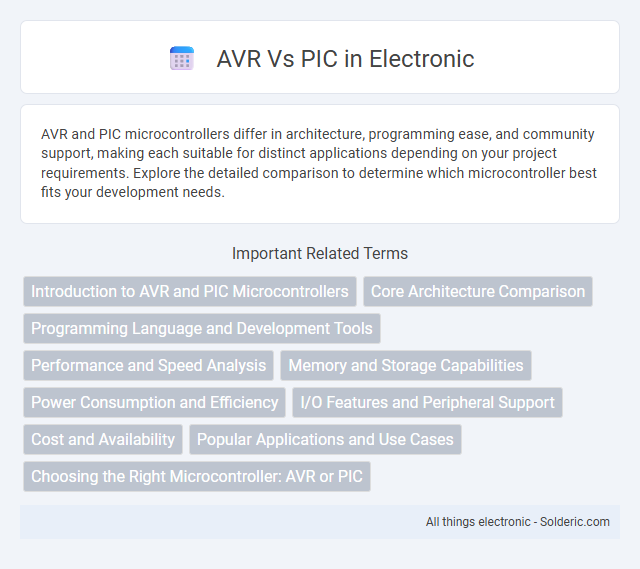AVR and PIC microcontrollers differ in architecture, programming ease, and community support, making each suitable for distinct applications depending on your project requirements. Explore the detailed comparison to determine which microcontroller best fits your development needs.
Comparison Table
| Feature | AVR Microcontrollers | PIC Microcontrollers |
|---|---|---|
| Manufacturer | Microchip Technology (Originally Atmel) | Microchip Technology |
| Architecture | RISC, 8-bit, 16-bit, 32-bit | RISC, 8-bit, 16-bit, 32-bit |
| Instruction Set | Reduced Instruction Set, mostly single-cycle instructions | Reduced Instruction Set, mostly single-cycle but some multi-cycle |
| Clock Speed | Up to 20 MHz (AVR 8-bit), higher for 32-bit models | Up to 64 MHz (PIC 32-bit), lower for 8-bit |
| Memory | Flash up to 256 KB, SRAM varies by model | Flash up to 512 KB, SRAM varies by model |
| Peripherals | Timers, ADC, USART, SPI, I2C, PWM | Timers, ADC, USART, SPI, I2C, PWM, enhanced peripherals on high-end |
| Power Consumption | Generally low power, efficient in sleep modes | Low power options available, varies by series |
| Development Tools | AVR Studio (Microchip Studio), Atmel ICE, GNU Toolchain | MPLAB X IDE, PICkit programmers, MPLAB XC Compilers |
| Application | Embedded systems, IoT, hobbyist projects, educational | Embedded control, industrial, automotive, consumer electronics |
| Price | Generally lower cost | Varies by model, often competitive |
Introduction to AVR and PIC Microcontrollers
AVR and PIC microcontrollers are popular embedded systems used in various electronics projects and applications. AVR microcontrollers, developed by Atmel, are known for their efficient RISC architecture and ease of programming using the AVR Studio IDE. PIC microcontrollers, produced by Microchip Technology, offer a wide range of devices with robust peripherals and flexible power management, making them suitable for diverse industrial and consumer applications.
Core Architecture Comparison
AVR microcontrollers feature a modified Harvard architecture with a single-level pipeline, enabling efficient instruction throughput and faster execution speeds. PIC microcontrollers typically use a Harvard architecture with separate program and data memory buses, but many models have a simpler pipelining approach that can affect overall performance. Understanding the core architecture differences between AVR and PIC helps you choose the right microcontroller for your application based on speed, efficiency, and code complexity.
Programming Language and Development Tools
AVR microcontrollers primarily support programming in C and assembly language, with development tools like Atmel Studio and MPLAB X providing robust debugging and simulation features. PIC microcontrollers also use C and assembly but benefit from Microchip's MPLAB X IDE and XC compilers, known for their wide device support and optimization capabilities. Your choice between AVR and PIC can significantly impact development efficiency depending on the preferred programming environment and available toolchains.
Performance and Speed Analysis
AVR microcontrollers offer higher clock speeds and efficient single-cycle execution, resulting in faster instruction throughput compared to many PIC variants, which often operate at lower clock rates and require multiple cycles per instruction. The AVR architecture's optimized Harvard design enables simultaneous instruction and data access, enhancing overall performance in time-critical applications. PIC microcontrollers, however, provide low-power modes and cost-effective solutions but generally lag in raw processing speed against comparable AVR models.
Memory and Storage Capabilities
AVR microcontrollers typically offer flash memory ranging from 8 KB to 256 KB, with SRAM sizes between 512 bytes and 8 KB, suitable for moderate storage needs. PIC microcontrollers provide a broader range of memory options, including flash memory from 256 bytes to over 2 MB and SRAM from 16 bytes to 128 KB, accommodating more complex applications. Your choice between AVR and PIC will depend on the memory and storage requirements of your embedded project, with PIC often favored for larger memory capacities.
Power Consumption and Efficiency
AVR microcontrollers generally offer lower power consumption and higher efficiency due to their optimized RISC architecture and efficient sleep modes, making them ideal for energy-sensitive applications. PIC microcontrollers also provide low power options but typically consume more power during operation compared to AVRs, especially in complex tasks. Your choice should consider specific power profiles and operational requirements to maximize efficiency in embedded systems.
I/O Features and Peripheral Support
AVR microcontrollers offer versatile I/O features with multiple digital and analog pins, supporting PWM, ADC, and UART interfaces, making them ideal for applications requiring flexible sensor integration. PIC microcontrollers provide extensive peripheral support including enhanced timers, comparators, and integrated communication modules like SPI, I2C, and CAN, favoring industrial and automotive applications. Both platforms deliver robust digital I/O capabilities, but PIC devices generally offer broader peripheral options tailored for complex embedded systems.
Cost and Availability
AVR microcontrollers generally offer a competitive price point, making them a cost-effective choice for budget-sensitive projects. PIC microcontrollers are widely available due to Microchip's extensive distribution network, ensuring easy access for various applications. Your decision might hinge on balancing the affordability of AVR against the broad availability and ecosystem support of PIC devices.
Popular Applications and Use Cases
AVR microcontrollers are widely used in hobbyist electronics, educational projects, and small embedded systems due to their ease of programming and extensive community support. PIC microcontrollers find greater adoption in industrial automation, automotive systems, and medical devices because of their robust architecture, wide range of variants, and long-term availability. Your choice between AVR and PIC should consider the specific application requirements, such as processing power, power consumption, and peripheral integration.
Choosing the Right Microcontroller: AVR or PIC
Choosing the right microcontroller between AVR and PIC depends on your project requirements such as performance, power consumption, and development ecosystem. AVR microcontrollers offer ease of programming with extensive community support, making them ideal for rapid prototyping, while PIC microcontrollers provide a broad range of options with robust low-power features suited for industrial applications. Your decision should align with factors like available development tools, code efficiency, and specific hardware capabilities to ensure optimal functionality.
AVR vs PIC Infographic

 solderic.com
solderic.com